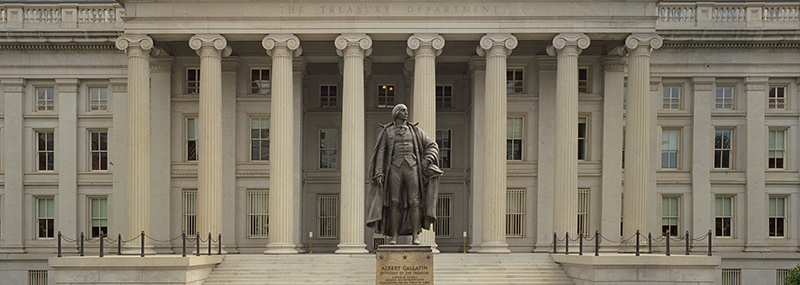by Fidelity Viewpoints
Key takeaways
- Congressional debates over the debt ceiling have, in the past, produced turmoil in financial markets. Many investors view the end of the debt ceiling suspension after July 31 with trepidation. The borrowing limit was suspended in 2019.
- At this time, there is reason to believe that the debt ceiling situation will be resolved with few, if any, political fireworks. Of course, this could always change.
The national debt is about to collide with the federal debt ceiling again. An agreement reached in 2019 to suspend the federal borrowing limit ends after July 31.
Investors with long memories may be nervous as this year's deadline approaches. But collective wisdom and history suggest that the issue will likely be resolved—possibly after some tense political negotiations.
Default is unthinkable—so many experts aren't worried
The debt ceiling has, in the past, spurred contentious and prolonged debate about fiscal responsibility and the growing national debt.
That's not expected to happen in 2021—there may not be much appetite in Congress for a prolonged fight about debt and spending at this time.
"In prior debates over the limit, some legislators sought to leverage the issue to instill fiscal discipline. The current makeup of Congress doesn't enable that, plus there's more acceptance of the debt in fighting the pandemic," says James Febeo, senior vice president of government relations at Fidelity.
In 2011, the disagreements went so far that the credit rating agency Standard & Poor's downgraded the US credit rating to AA+, one step below the best rating of AAA, where it still remains. Standard & Poor's cited the growing deficit and the prolonged debate as reasons for the downgrade.
Typically, raising the debt ceiling is not a battle legislators want to fight. Administration officials usually work behind the scenes to convince legislators of the importance of raising the limit relatively quickly and without fanfare. This approach helps limit financial market uncertainty, minimizing the potential for government borrowing costs to increase amid a debt-ceiling debate, while reducing investor concerns.
Many of the same policymakers who negotiated the 2011 raise will be at the table 10 years later, such as President Biden, Senate Minority Leader McConnell, House Speaker Pelosi, and House Majority Leader Hoyer.
Today's debt
One thing separating today's debt debate from those of the past is the larger-than-ever national debt. Publicly held US debt topped 100% of GDP in 2020 and is expected to reach 102% by the end of 2021.
And the debt is projected to increase significantly in the future. The Congressional Budget Office (CBO) projects a federal budget deficit of $2.3 trillion in 2021—the second largest deficit since 1945.
What if the US debt ceiling is not raised?
Unless a deal is reached to suspend or raise the debt limit, the US will be in danger of defaulting on our national debt. There are some steps the Treasury can take to forestall a default, including spending down saved cash and other emergency measures. But those may only delay hitting the ceiling until sometime in the fall or as early as August, according to Treasury Secretary Janet Yellen in testimony to a Senate subcommittee on June 23.
If all of Treasury's cash balances are drawn and extraordinary measures have been exhausted, the Treasury would be at the limit of the debt ceiling. Such an outcome has not occurred in the modern era, and it remains uncertain as to exactly what developments would transpire next.
However, if Congress still does not raise the debt ceiling, the US government would have to operate on a cash-flow basis, meaning that outflows (including interest payments on existing Treasury debt) would have to be funded by inflows (i.e., tax receipts and fees). Operating in this manner would require prioritization of payments, which could have several negative implications.
For one, this prioritization would place some counterparties in a subordinate position, which could spook the markets. For instance, during the debt debate in 2013 when the US was only days away from default, prioritization of payments was discussed as a possible option. While principle and interest payments could potentially continue to flow to bondholders, other payments like Social Security benefits could be suspended.
Also, the rating agencies would most likely place the sovereign rating of the United States under review and would potentially lower the rating if a debt ceiling increase was not enacted. That could significantly increase the cost of borrowing at the national level.
Furthermore, critical functions to operate the government, including spending for military, Social Security and other programs, would likely be interrupted, pressuring economic activity. Finally, the timing of tax collections is always uncertain, creating the potential for an inadvertent missed interest payment.
Possible implications of a default
An actual default is highly unlikely because of the reverberations that could be expected, including:
What can investors do?
It's clearly in the best interest of the country to resolve any debt ceiling issues.
“This isn’t anticipated to be a long-lasting issue. If it does create some volatility in markets, it could be a good rebalancing opportunity,” says Lars Schuster, institutional portfolio manager in Fidelity’s Strategic Advisers group.
Still, there will always be times of uncertainty. It's important to take a long-term view of your investments and review them regularly to make sure they line up with your time frame for investing, risk tolerance, and financial situation. Ideally, your investment mix is one that offers the potential to meet your goals while also letting you rest easy at night.














